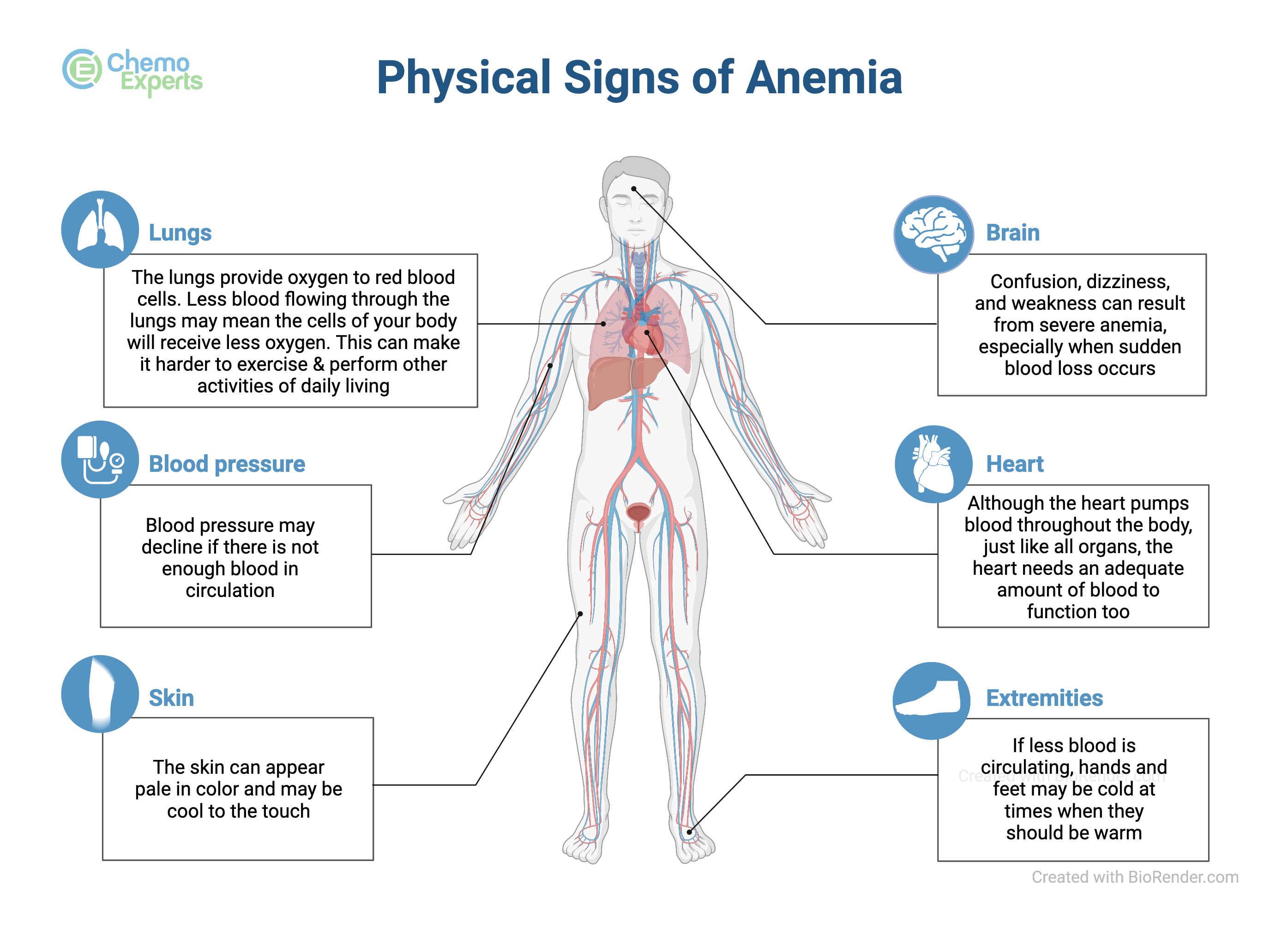Side Effect: Anemia
What is Anemia?
Anemia is a significant side effect seen with certain types of cancer therapy. It is defined as having less blood than normal. Anemia can be measured in several different ways using common laboratory markers that are provided by the complete blood count, or CBC. The most common lab tests used are the hemoglobin (Hb) and hematocrit (Hct).
What does anemia look like?
Laboratory markers of anemia:
Although the two measurements have different units, in most cases the hemoglobin (Hb) can be calculated by dividing the hematocrit by 3.
- For example, if the hematocrit is 30%, the hemoglobin is usually about 10 g/dL.
- For example, if the hematocrit is 36%, the hemoglobin is usually about 12 g/dL.
Clinical signs and symptoms of anemia, from head to toe, may include:
- Dizziness
- Lightheadedness
- Shortness of breath (dypnea)
- Fast heart rate (tachycardia)
- Chest pain
- Pale skin
- Exercise intolerance
- Cold hands and feet
Anemia

Click to enlarge
Physical signs and symptoms resulting from anemia can be seen here. Because almost all body tissues need a continuous supply of oxygen, most cells and organs are affected when the body is anemic. Displayed here are a few organ symptoms that are affected by anemia and what a patient may experience if they become anemic.
Who gets anemia and when does it occur?
Anemia can develop as a result of 3 main causes leading to fewer red blood cells in the body. These include:
1) Low production of red blood cells by the bone marrow
2) Increased destruction of red blood cells (RBCs)
3) Loss of RBCs
- Anemia can often be further sub-divided into causes owing to drugs, bugs (bacteria, viruses, or fungus), and diseases, disorders, or conditions.
Onset: Anemia can occur over weeks to months as a result of low RBC production due to the bone marrow-suppressing effects of chemotherapy. Or, anemia can happen quickly (over hours or days) resultng from RBC loss due to medications that increases the risk of bleeding.
How long does anemia last?
Depending upon what causes anemia, it may be short in duration if one is able to identify and correct all suspected contributing factors of anemia. However, if anemia is due to a disease or disorder that is not responding to treatment, the anemia may be long-term in duration.
How do you prevent anemia?
On occasion, cancer-and chemotherapy-induced anemia can be prevented by addressing risks for decreased RBC production, increased RBC destruction, and RBC loss. Strategies aimed at accomplishing this include, but are not limited to:
- Production: Assessing whether the body is deficient in RBC building blocks such as folic acid (vitamin B9), vitamin B12, and iron
- Loss: Ensuring medications, including as over-the-counter medications (such as aspirin, ibuprofen, and naproxen) are not contributing to bleeding. Importanly, medications can cause small amounts of blood to be lost in the stool, eventhough bowel movements may appear to be normal (eg. no bright red blood in feces, or black tarry stools)
- Destruction: RBC destruction as a result of drugs, bugs, or diseases is relatively rare, and may or may not be able to be prevented using medications or lifestyle modifications
How do you treat anemia?
The treatment of anemia may include multiple modalities, and will likely depend upon the severity of anemia and the onset in which it appeared (in other words, how quickly did it develop?):
Anemia, immediate correction:
A packed RBC (pRBC) transfusion may be offered if there are signs or symptoms of organ damage or low oxygenation. One unit of pRBCs may take around 2 hours to transfuse. Likewise, two units of pRBCs may take around 4 hours to transfuse.
Anemia, non-immediate correction necessary:
- Iron deficiency is a common cause of anemia in patients with cancer. If iron indices (labs used to detect iron deficiency in the body) reveal that iron is low, intravenous iron infusions may be offered. Available products include:
- Iron Dextran (InFeD®)
- Iron Sucrose (Venofer®)
- Ferric Carboxymaltose, often referred to as FCM (Injectafer®)
- Ferric Gluconate (Ferrlecit®)
- Ferric Derisomaltose (Monoferric®)
- Ferumoxytol (Feraheme®)
- Patients with reduced renal function or those receiving bone marrow-suppressing chemotherapy may qualify for hormone injections that boost the production of RBCs fro mthe bone marrow. The medications are similar to a naturally-occuring hormone that your body's kidneys produce called erythropoietin, or epo. In response to anemia, your kidney senses low oxygen levels in the blood and makes epo in response. Epo then moves to your bone marrow and binds to RBC precursor cells and signal them to make more RBCs. Available erythropoietic-stimulating agents, also known as ESAs, include:
- Epoetin alfa (Procrit®, Epogen®, Retacrit®)
- Darbepoetin alfa (Aranesp®)
Created: February 17, 2022
Updated: March 11, 2022

